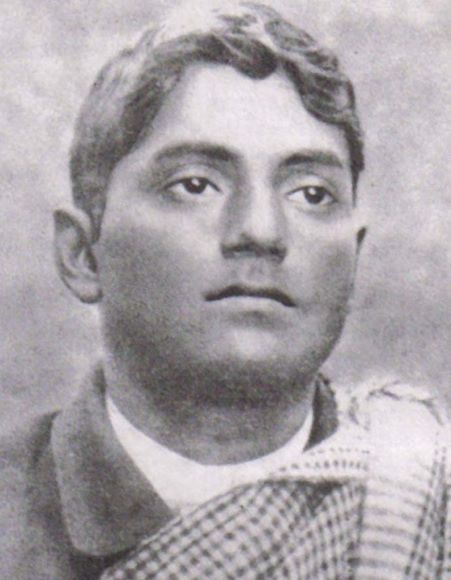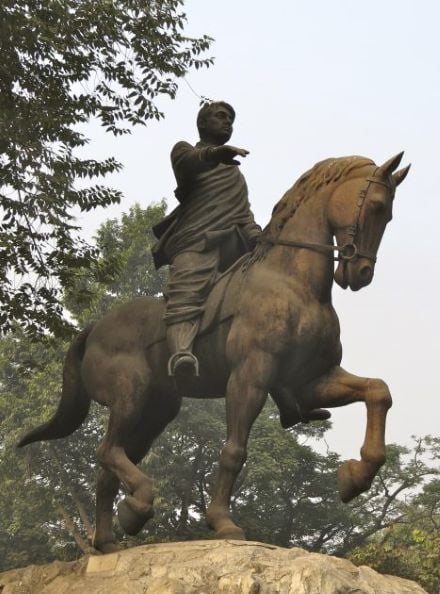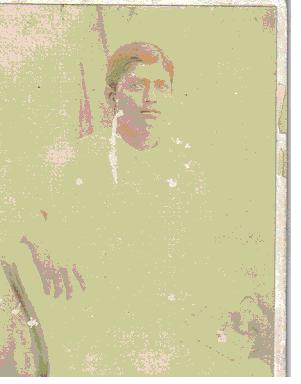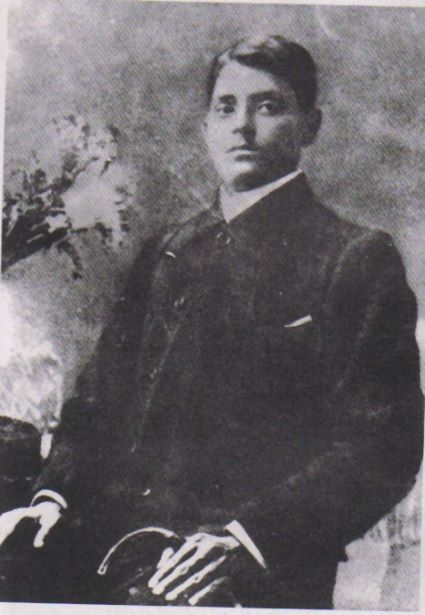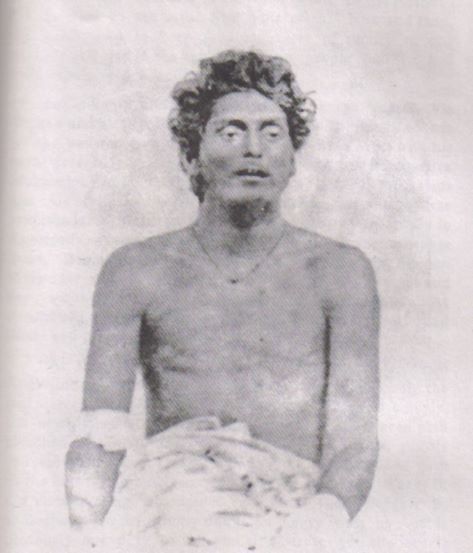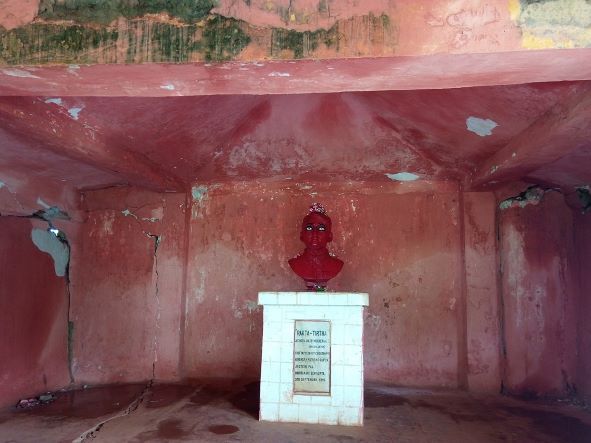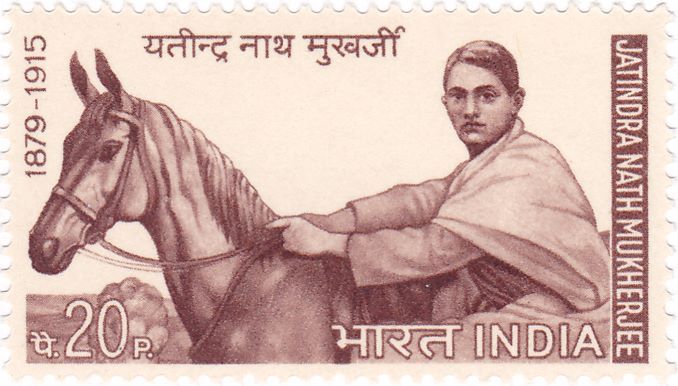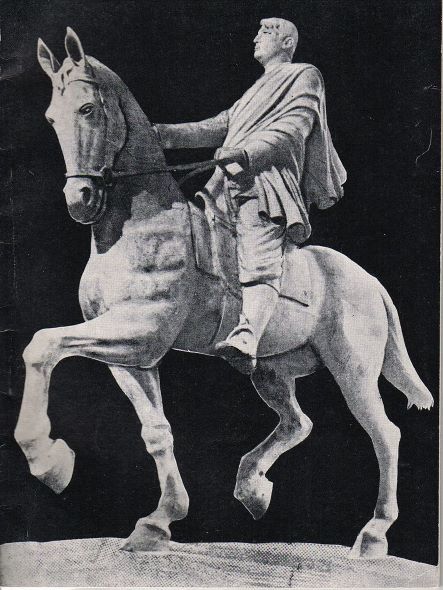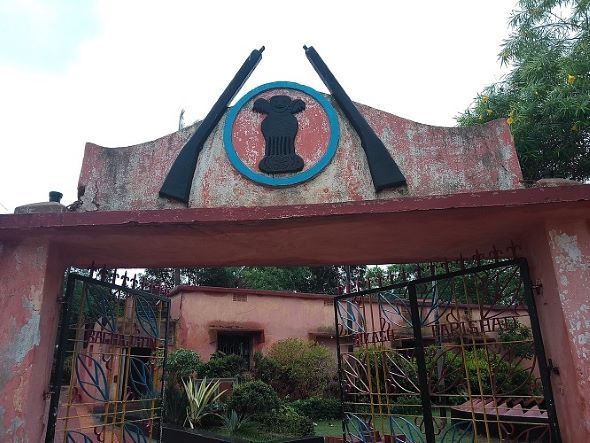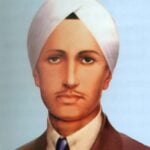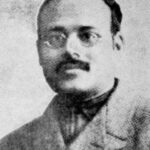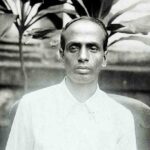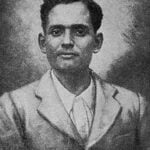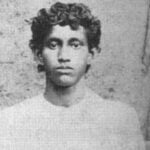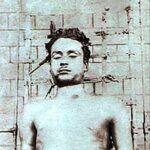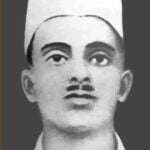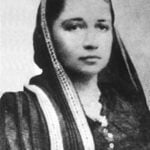Bagha Jatin Age, Death, Wife, Children, Family, Biography & More
| Bio/Wiki | |
|---|---|
| Name Earned | Bagha Jatin [1]The Better India |
| Real name | Jatindranath Mukherjee [2]The Better India |
| Profession | Indian independence activist |
| Famous for | Freedom Struggle |
| Physical Stats & More | |
| Eye Colour | Black |
| Hair Colour | Black |
| Personal Life | |
| Date of Birth | 7 December 1879 (Sunday) |
| Birthplace | Kushtia, Bengal Presidency, British India (now Bangladesh) |
| Date of Death | 10 September 1915 |
| Place of Death | Balasore, Bengal Presidency, British India |
| Age (at the time of death) | 35 Years |
| Death Cause | Gunshot Wound [3]The Better India |
| Zodiac sign | Sagittarius |
| Nationality | British Indian |
| Hometown | Kushtia, Bengal Presidency, British India (now Bangladesh) |
| School | Krishnanagar Anglo-vernacular School (A.V. School), Nadia, West Bengal |
| College/University | The Calcutta Central College (now Khudiram Bose College), West Bengal |
| Educational Qualification(s) | • School education at Krishnanagar Anglo-vernacular School (A.V. School), Nadia, West Bengal • Fine Arts Degree from the Calcutta Central College (now Khudiram Bose College), West Bengal [4]Byju's |
| Caste | Brahmin [5]Underground Asia: Global Revolutionaries and the Assault on Empire |
| Relationships & More | |
| Marital Status (at the time of death) | Married |
| Marriage Date | Year, 1900 |
| Family | |
| Wife | Indubala Banerjee 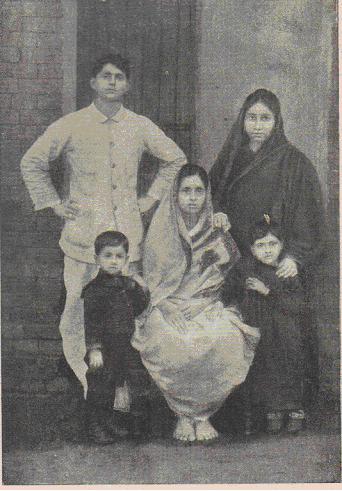 |
| Children | Sons- 3 • Atindra (1903–1906) • Tejendra (1909–1989) • Birendra (1913–1991) Daughter- Ashalata (1907–1976) |
| Parents | Father- Umeshchandra Mukherjee Mother- Sharatshashi |
| Siblings | Elder Sister- Binodbala |
Some Lesser Known Facts About Bagha Jatin
- Bagha Jatin was an Indian freedom fighter from the Bengal Presidency. During his revolutionary activities, he became the principal leader of Bengal’s revolutionary organisation ‘the Jugantar Party.’
- When Jatin was five years old, his father died. He was then brought up at his maternal home in Kayagram with his elder sister, Benodebala. His father had knowledge of Brahmanic studies, and he was good at horse riding. His mother was a social worker and a poet. She brought up Jatin in such a manner so that he could become a courageous, strong, and selfless man. She was inspired by the writings of the great leaders of her time such as Bankimchandra Chatterjee and Yogendra Vidyabhushan and had knowledge of Indian social and political changes. Her brother, Basanta Kumar Chattopadhyay, was a noted lawyer of Bengal, and the great Indian philosopher Rabindranath Tagore was one of his clients.
- The young Jatin was popular for his physical bravery and strength. His nature was kind and cheerful. He liked to act in religious plays on stage and often portrayed god-lover characters including Prahlad, Dhruva, Hanuman, and Raja Harish Chandra. At a very young age, he started encouraging several playwrights to write and organise plays based on patriotism. He also motivated the musicians of his time for the spread of nationalism in the country through their patriotic songs.
- In 1895, Jatin passed the entrance examination for the Calcutta Central College (now Khudiram Bose College) when he was studying in the last year of his school, Krishnanagar Anglo-vernacular School (A.V. School). Soon after finishing his school studies, he joined the college. While pursuing his graduation, he started taking lessons of steno typewriting from Mr Atkinson so that he could get more job opportunities.
- Bagha Jatin was inspired by Swami Vivekananda and his ideologies, thinking, and visions. During his college days, Jatin started meeting Vivekananda who influenced Jatin by stating that the spiritual progress of humanity could be possible only when India would be a politically independent country. Swami taught him the art to conquer the five senses. Soon, both of them together raised a small army of young volunteers, who had strong physiques to serve the Indians during famines, epidemics, and floods. Swami Vivekananda’s Irish disciple Sister Nivedita, was assisted by Jatin and Vivekananda in the “man-making” venture. J. E. Armstrong, Superintendent of the colonial Police, once stated,
Owed his preeminent position in revolutionary circles, not only to his qualities of leadership, but in great measure to his reputation of being a Brahmachari with no thought beyond the revolutionary cause.”
Jatin’s slogan was:
Amra morbo, jagat jagbe” — “We shall die to awaken the nation.”
- Swami Vivekananda sent Jatin to the Gymnasium of Ambu Guha to practice wrestling when Swami noticed that Jatin intensely desired to fight and die for a cause. While pursuing his wrestling classes, he met Sachin Banerjee, who soon turned into his mentor. Sachin Banerjee was the son of Yogendra Vidyabhushan, who was a popular author and wrote the biographies of Mazzini and Garibaldi. Soon, Jatin found the education system of the colonial system apathetic, and he left for Muzaffarpur in 1899.
- Jatin got married to Indubala in 1900, and they had four children. His first child named Atindra died at the age of three, and devastated by the grief, Jatin, along with his wife and sister, went on a pilgrimage in Haridwar, where he took initiation from the saint Bholanand Giri.
- In March 1906, they returned to their village in Koya. Soon after reaching the village, Jatin received information that a tiger in the area was disturbing the villagers and their lives. To find the tiger, Jatin went to the nearby jungle, where he found the Royal Bengal tiger and fought with it at close quarters. During the fight, he got wounded and struck the neck of the tiger with a Gorkha dagger (Khukuri), which resulted in the killing of the tiger instantly. Lt-Colonel Suresh Prasad Sarbadhikari, a well-known surgeon of Calcutta, took the whole responsibility to provide treatment to Jatin whose whole body was poisoned by the tiger with its nails and was brutally wounded by it. Soon, Dr Sarbadhikari got impressed with the exemplary heroism of Jatin and published an article in the English press about Jatin and his heroic deeds. Later, Jatin was honoured with a shield in which a scene of him killing the tiger was engraved by the Government of Bengal. Since then, the title ‘Bagha,’ meaning ‘Tiger,’ was affixed with his name. Soon after the incident, some of Jatin’s followers such as Taraknath Das, Guran Ditt Kumar, and Surendramohan Bose started creating a base of patriotism among the Indians living in the United States by publishing periodicals with revolutionary literature.
- Reportedly, Jatin was one of the co-founders of the Anushilan Samiti in 1900. As a member of this revolutionary organisation, he started various branches of the venture in different districts of Bengal. This statement was reported in Daly’s Report. It wrote,
A secret meeting was held in Calcutta about the year 1900. The meeting resolved to start secret societies with the object of assassinating officials and supporters of Government. One of the first to flourish was at Kushtea, in the Nadia district. This was organised by one Jotindra Nath Mukherjee [sic!].”
Further, Nixon reported,
The earliest known attempts in Bengal to promote societies for political or semi-political ends are associated with the names of the late P. Mitter, Barrister-at-Law, Miss Saralabala Ghosal and a Japanese named Okakura. These activities commenced in Calcutta somewhere about the year 1900, and are said to have spread to many of the districts of Bengal and to have flourished particularly at Kushtia, where Jatindra Nath Mukharji [sic!] was leader.”
- After the establishment of Anushilan Samiti, it’s one branch was to be inaugurated in Dacca for which Jatin met Sri Aurobindo at Yogendra Vidyabhushan’s place, where Jatin decided to collaborate with him in attacking the British regiments and organising a secret society that aimed at an armed uprising all over India. According to W. Sealy’s report,
Connections with Bihar and Orissa” notes that Jatin Mukherjee “a close confederate of Nani Gopal Sen Gupta of the Howrah Gang (…) worked directly under the orders of Aurobindo Ghosh.”
- A procession was organised in Calcutta to celebrate the visit of the Prince of Wales to India in 1905. All the people of Calcutta were gathered on the streets to attend the procession. A carriage of some Indian ladies was parked near the carriage of the Prince. On this carriage, some English military men were sitting with their feet dangling over the faces of the passengers. Jatin noticed the same and warned these military men, but they started commenting obscene remarks following which he rushed up on the roof and slapped each of them and dropped them on the ground while pointing toward the public and Prince. Reportedly, Jatin already knew that John Morley, the Secretary of the State, often receives complaints from the Indian citizens about the wrong attitude of the English people toward them. According to an article on Bagha Jatin,
The use of rough language and pretty free use of whips and sticks, and brutalities of that sort…” He will be further intimated that the Prince of Wales, “on his return from the Indian tour had a long conversation with Morley [10/5/1906] (…) He spoke of the ungracious bearing of Europeans to Indians.”
- Later, Bagha Jatin, along with Barindra Kumar Ghosh, established a bomb manufacturing factory near Deoghar. Barindra Kumar established a factory at Maniktala all alone. Jatin was against the decision of untimely terrorist actions; however, Barindra Kumar Ghosh believed that creating terror was not the only thing but eliminating certain Indian and British officials, who were working for the colonial government, was necessary. Jatin established another organisation called,
A decentralised federated body of loose autonomous regional cells.”
- Thereafter, Bagha Jatin started organising several relief missions with volunteer doctors to help the Indian people during natural calamities like floods and epidemics. Various religious gatherings such as the Ardhodaya, the Kumbha Mela, and the annual celebration of Ramakrishna’s birth were often attended by Jatin. It was suspected by the British government that following these missions, Jatin was focussing on organising meetings with the regional leaders for recruiting revolutionary freedom fighters to fight against the British supporters.
- In 1906, Sir Daniel started helping Jatin by sending intellectual students abroad from India so that they could pursue higher studies there while learning the military craft.
- Gradually, Bagha Jatin became popular for his professional competence in revolutionary activities following which he was sent to Darjeeling for three years on some special work in 1907. According to a media source, he started a branch of the Anushilan Samiti, called the Bandhab Samiti in Darjeeling. It wrote,
From early youth he had the reputation of a local Sandow and he soon attracted attention in Darjeeling in cases in which (…) he tried to measure the strength with Europeans. In 1908 he was leader of one of several gangs that had sprung up in Darjeeling, whose object was the spreading of dissatisfaction, and with his associates he started a branch of the Anushilan Samiti, called the Bandhab Samiti.”
- In April 1908, Bagha Jatin got involved in a fight with a group of Engish troops including Captain Murphy and Lt Somerville at Siliguri railway station. This case was widely covered by the media during the legal proceedings. Upon knowing that the media was mocking in its articles that an Indian single-handedly thrashed a few Englishman, Wheeler advised the English officers to withdraw their case against Jatin. Jatin was then released from custody, and the Magistrate warned him not to misbehave in the future to which Jatin replied that he would not regret acting in a similar way in self-defence in the future and would revenge for the rights of his countrymen if needed. Once Wheeler was in a pleasant mood, and he asked Jatin how many could he fight all alone to which Jatin instantly replied,
Not a single one, if it is a question of honest people; otherwise, as many as you can imagine! I can’t win against even one man if he’s righteous, but I am blessed to be able to take down plenty of the wrong sort.”
- In 1908, Jatin was accused in the Alipore Bomb Case soon after the Muzaffarpur incident. Jatin handled the leadership of the secret society, i.e., the Jugantar Party during the Alipore proceedings. Meanwhile, he tried hard to strengthen the links between the central organisation of the Jugantar Party in Calcutta and its various associations that had spread in different regions of North India such as Bengal, Bihar, Odisha, and UP. Later, Jatindranath Mukherjee, along with his companion Atul Krishna Ghosh, founded Pathuriaghata Byam Samity. This organisation was an important centre for the armed revolutionaries during the Indian national movement. These organisations also focussed on social services such as running night schools for adults, homoeopathic dispensaries, training centres to open small-scale cottage industries and agricultural innovations.
- To restore the confidence of Indian citizens in the Indian independence movement, Jatin began organising a series of courageous actions in Calcutta soon after the Alipore Case. According to an Indian author, Arun Chandra Guha these bold revolutionary activities brought Jatin into the limelight. Guha mentioned in one of his writings,
These brought him into the limelight of revolutionary leadership although hardly anybody outside the innermost circle ever suspected his connection with those acts. Secrecy was absolute in those days – particularly with Jatin.
- According to Sidney Arthur Taylor Rowlatt, in his book titled Sedition Committee Report 1918, Jatin was the inventor of the new feature in revolutionary crime when he introduced a bank robbery method on automobile taxi cabs. Rowlatt wrote,
Almost contemporaneous with the anarchist gang of Bonnot well known in France, Jatin invented and introduced in India bank robbery on automobile taxi-cabs, ” a new feature in revolutionary crime. “
- During this period, under Jatin’s leadership, various outrages were executed such as on 7 November 1908, they attempted to assassinate the Lt Governor of Bengal, on 10 February 1909, the assassination of the Prosecutor Ashutosh Biswas by Charu Chandra Bose, and on 24 January 1910, the assassination of the Deputy Superintendent of Police, Shamsul Alam. Alam was popular for torturing and extracting information from imprisoned revolutionaries. Soon, British police officers detained Biren Datta Gupta, the killer of Shamsul Alam, and during the court trials, Gupta disclosed that Bagha Jatin was his leader. Gupta was hanged on 21 February 1910. When the Britishers were in deep grief with such assassinations, the Viceroy Minto declared publicly,
A spirit hitherto unknown to India has come into existence, a spirit of anarchy and lawlessness which seeks to subvert not only British rule but the Governments of Indian chiefs…”
- In the Howrah-Sibpur conspiracy case, Jatin, along with his forty-six co-conspirators, was arrested by ACP Tegart on 27 January 1910 on murder charges. This case was popularly known as the Howrah Gang Case. He was charged in the following cases:
Conspiracy to wage war against the King-Emperor” and “tampering with the loyalty of the Indian soldiers” (mainly with the 10th Jats Regiment) posted in Fort William, and soldiers in Upper Indian Cantonments.”
However, the decentralised way of working of Bagha Jatin left no evidence behind following which most of these revolutionaries were acquitted and the case failed.
- During his detention period at the Howrah jail, Jatin came in contact with some noted revolutionary activists, who were his fellow prisoners and were associated with various revolutionary groups, which were operating in different parts of Bengal. They were all accused in the same case. Some of his envoys in Howrah Jail informed Jatin that Germany was declaring war against England very soon. Jatin was seeking this opportunity for a long time so that he could establish an armed mutiny along with the Indian soldiers in various regiments against the Britishers.
- The statement made by F.C. Daly on the Howrah Conspiracy case was,
The gang is a heterogeneous one, with several advisers and petty chiefs… From the information we have on record we may divide the gang into four parts: (1) Gurus, (2) Influential supporters, (3) Leaders, (4) Members.”
- J.C. Nixon reported the Howrah Conspiracy Case as,
Although a separate name and a separate individuality have been given to these various parties in this account of them, and although such a distinction was probably observed amongst the minor members, it is very clear that the bigger figures were in close communication with one another and were frequently accepted members of two or more of these samitis. It may be taken that at some time these various parties were engaged in anarchical crime independently, although in their revolutionary aims and usually in their origins they were all very closely related.”
- Viceroy Lord Hardinge wrote to Earl Crewe (H.M.’s Secretary of State for India) soon after the release of Jatin in the Howrah Conspiracy case:
As regards prosecution, I (…) deprecate the net being thrown so wide; as for example in the Howrah Gang Case, where 47 persons are being prosecuted, of whom only one is, I believe, the real criminal. If a concentrated effort had been made to convict this one criminal, I think it would have had a better effect than the prosecution of 46 misguided youths.”
Hardinge further stated on 28 May 1911,
The 10th Jats case was part and parcel of the Howrah Gang Case; and with the failure in the latter, the Government of Bengal realised the futility of proceeding with the former… In fact, nothing could be worse, in my opinion, than the condition of Bengal and Eastern Bengal. There is practically no Government in either province…”
- Jatin was acquitted in February 1911 in the Alipore Bomb case, and soon after his release, he stopped his revolutionary missions. This calmness signalled that he was planning something big. He met the German Crown Prince during his visit to India and had a deal for the arms supply. Meanwhile, Jatin lost his government job, and he went to Calcutta and took a contract for the construction of the Jessore–Jhenaidah railway line. During this business, he travelled all across the provinces of Bengal on horse or bicycle to revitalise the revolutionary organisations again with a valid pretext.
- He then went on a pilgrimage with his family members to Haridwar, where he met his Guru, Bholananda Giri. They then visited Brindavan, where Jatin met Swami Niralamba, who was a revolutionary before becoming a saint. Niralamba informed Jatin that he had set up some revolutionary units in Uttar Pradesh and Punjab. Rash Behari Bose and Lala Hardayal were the leaders of the revolutionary activities of these regions. Soon after returning from the pilgrimage, Jatin began reorganising the revolutionary aims of the Jugantar Party. In 1913, Jatin organised relief work during the Damodar flood, which affected the main districts of Burdwan and Midnapore. According to some authors,
Jatin “never asserted his leadership, but the party members in the different districts acclaimed him as their leader.”
- Rasbehari Bose was inspired by Jatin’s relief work during the floods. Bose reached Benares to accompany Jatin. Bose was inspired by Jatin and used to call him a real leader of men. In 1913, Bose had a meeting with Jatin in which they discussed that there should be an armed uprising similar to the revolt of 1857. Bose was so impressed with the passionate personality and energy of Jatin that he renewed a negotiation deal with the native officers posted at the Fort William of Calcutta to organise the scattered forces. They also started emigrating some Indian revolutionaries to Europe and the United States. A Bengali author named Dhan Gopal Mukerji, who was settled in New York, stated in one of his books that when Jatin and his companions succeeded in disturbing the equilibrium of the British government, then it gave extraordinary powers to the British police. Dhan Gopal wrote,
Before 1914 we succeeded in disturbing the equilibrium of the government… Then extraordinary powers were given to the police, who called us anarchists to prejudice us forever in the eyes of the world… Dost thou remember Jyotin, our cousin – he that once killed a leopard with a dagger, putting his left elbow in the leopard’s mouth and with his right hand thrusting the knife through the brute’s eye deep into its brain? He was a very great man and our first leader. He could think of God ten days at a stretch, but he was doomed when the Government found out that he was our head.”
- The representatives of Jatin such as Taraknath Das, Guran Ditt Kumar, and Surendramohan Bose had been organising evening schools for Indian immigrants in Vancouver, Seattle, Portland, and San Fransisco since 1907. The students of these schools were mainly from Hindu and Sikh communities and were taught to write and read simple English. In these schools, they were also taught about their rights in the USA and their obligations toward their own motherland. During this time, an English periodical titled Free Hindustan, which was sponsored by the Irish revolutionaries, and another titled Swadesh Sevak, written in Gurmukhi, became popular. Shyamji Krishna Varma was managing the revolutionary organisations in Calcutta and London. Guran Ditt Kumar move to Manilla in May 1913, and there he created a satellite that linked Asia with the America West Coast. Various revolutionary lectures at the major centres of Indian immigrants were delivered by Lala Har Dayal, and in these lectures, as an ardent patriot, he openly revolted against British rule in India.
- In September 1914, at Zürich, an International Pro-India Committee was established soon after the report of World War I. Later, this organisation started spreading its branches and formed the Berlin Committee, or the Indian Independence Committee, which was headed by Virendranath Chattopadhyaya. The German government and the members of the Ghadar Party fully supported this organisation. Soon after the outbreak of World War I, several militants of the Ghadar party started moving to India to help India to fight with the arms, ammunition, and funds, which were earlier granted by the German government. Ambassador Bernstorff in Washington, along with Von Papen, send cargo consignments from California to the coast of the Bay of Bengal under the leadership of Jatin and his Jugantar party, which was planning to organise an armed revolt against the colonial rule in India. The armed uprising was carried out in Uttar Pradesh and Punjab under the leadership of Rash Behari Bose. This international chain of armed revolution resulted under the leadership of Bagha Jatin and was popularly called the German Plot, the Hindu–German Conspiracy, or the Zimmermann Plan. Later, to organise funds for the Jugantar party and its activities, a series of dacoities called “Taxicab dacoities” and “Boat dacoities” was organised by its members. Satyendra Sen, along with Bagha Jatin, started interviewing Sikh soldiers who were posted at Dakshineshwar gunpowder magazine. According to a media source, Sen came to India along with Pingle and started tampering with British troops, but soon, Pingle was captured with bombs in Punjab. It read,
Sen is the man who came to India with Pingle. Their mission was specially to tamper with the troops. Pingle was captured in Punjab with bombs and was hanged, while Satyen was interned under Regulation III in the Presidency Jail.”
- Pingle and Kartar Singh Sarabha met Rash Behari Bose in North India as advised by Bagha Jatin. It was advised by the members of the Jugantar party that Jatin should move to a safer place as the police activities started increasing to prevent the uprising. Soon, Jatin shifted to Balasore on the Odisha coast. A business house named “Universal Emporium” was established as a constituent of Harry & Sons in Calcutta to transmit information about his organisation and the revolutionaries who moved abroad. Jatin was hiding at the Kaptipada village in Mayurbhanj, which was thirty miles away from Balasore.
- In April 1915, Jatin moved to Odisha, where he sent Naren Bhattacharya to Batavia to make a deal with the German authorities for the funds and arms. Naren, the German Consul, met the brother of Karl Helfferich, Theodore. Earlier, Theodore had assured Naren that he would assist the Indians in the arms revolution and said that a cargo filled with arms and ammunition was on its way. Some of Jatin’s plans and plots in acquiring the arms and ammunition were uncovered by the network of Czechoslovak revolutionaries and emigrants.
- Soon, the information about the cargo that was about to reach the shores of Odisha, particularly in the delta region of the Ganga, alerted the British officials. They sealed all the seashores on the eastern coast from the Noakhali–Chittagong side to Odisha. Several raids and searches were conducted by the British police on Harry & Sons and found that Jatin was staying with Manoranjan Sengupta and Chittapriya Ray Chaudhuri in Kaptipada village. Soon, a team from the Police Intelligence Department was sent to Balasore. Jatin’s comrades informed him about the police raids and requested him to shift from the area. However, Jatin wanted to take his comrades Nirendranath Dasgupta and Jatish with him, which delayed his departure from the Kaptipada village. This gave a big police force, which was headed by Europen officers from Calcutta and Balasore, to gather around his hiding place. Jatin and his friends escaped the police arrest and ran through the forests of Mayurbhanj. They reached the Balasore Railway Station. Later, police announced a reward to those who would help them to capture Jatin and his companions.
- On 9 September 1915, Jatin and his comrades reached a hillock at Chashakhand in Balasore after running through dense forests in rain. Chittapriya and his companions requested Jatin to run away to a safer place and assured him that he would guard Jatin from the rear. However, Jatin refused to leave them. A huge police force of the British government reached the spot, and soon, a gunfight started between them that lasted for seventy-five minutes. The revolutionaries had Mauser pistols, and the police were attacking them with modern rifles. The casualties were not recorded by the British government, but Chittapriya Ray Chaudhuri died during the arms fight. Jatin and Jatish were caught seriously injured by the Britishers. Manoranjan, Sengupta, and Niren were arrested by the police. On 10 September 1915, Bagha Jatin died in a hospital at Balasore.
- Charles Tegart, the Intelligence Chief and Police Commissioner of Bengal, paid a tribute to Jatin after his death. Charles stated,
Though I had to do my duty, I have a great admiration for him. He died in an open fight.”
Later, Charles admitted,
Their driving power (…) immense: if the army could be raised or the arms could reach an Indian port, the British would lose the War.”
- M. N. Roy, an Indian Marxist revolutionary, radical activist, and political theorist mentioned Bagha Jatin in one of his books in which he stated,
I could not forget the injunction of the only man I ever obeyed almost blindly[…] JatinDa’s heroic death […] must be avenged. Only a year had passed since then. But in the meantime, I had come to realise that I admired Jatin Da because he personified, perhaps without himself knowing it, the best of mankind. The corollary to that realisation was that Jatinda’s death would be avenged if I worked for the ideal of establishing a social order in which the best in man could be manifest.”
- Reportedly, Charles Tegart once told his colleagues that the statue of Jatin would have been built beside the statue of Nelson at Trafalgar Square if Jatin were an Englishman. He said,
If Jatindranath were an Englishman, his statue would have been built next to Nelson’s at Trafalgar Square.” [6]The Better India
- In 1958, a film titled Bagha Jatin was released based on the sacrifices of Jatin. This film was directed by Hiranmoy Sen.
- In 1970, the Government of India issued a postal stamp in his name to honour the attempts that he made to revolt against the colonial rule in India.
- In 1977, director Harisadhan Dasgupta made a film based on the revolutionary activities of Bagha Jatin. The Government of India’s Films Division produced this film.
- Later, Baghajatin, a locality in Kolkata, was named after him.
- A statue of Bagha Jatin was established at Barbati Girls High School, which is located near the banks of the river Budha Balanga in Balasore, where Jatin breathed his last.
- After the independence of India, in his memory, the Government of India constructed a park at Chashakhand, a place which is 15km east of Balasore, where Jatin and his companions fought an armed battle with the British force.
References/Sources:

